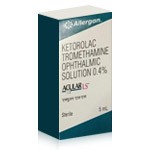Into the Eye: Understanding and Healing Corneal Abrasions


A corneal abrasion, often referred to as a scratched eye, is a painful injury to the surface of the cornea, the clear, dome-shaped tissue that covers the front of the eye. This condition is common and can occur when the delicate corneal tissue is damaged by physical trauma. Although corneal abrasions are usually treatable and tend to heal on their own, they can be serious if not properly managed. In this article, we will explore what a corneal abrasion is, how it is treated, whether it is serious, and the recovery timeline, with a focus on the role of Acular LS in treatment.
What is a Corneal Abrasion?
The cornea is made up of five layers of tissue, and an abrasion typically affects the outermost layer, known as the epithelium. This layer acts as a protective barrier against harmful microorganisms, dust, and other irritants. A corneal abrasion can occur from a variety of sources, such as an accidental poke in the eye, contact lens wear, foreign particles like sand or dust, or even rubbing the eyes too vigorously. The cornea is highly sensitive, and any damage to this area can cause intense pain, redness, and sensitivity to light.
Causes of Corneal Abrasion
A corneal abrasion can result from both minor and more serious incidents. Common causes include:
- Foreign objects: Things like dust, sand, or eyelashes can irritate the cornea and cause scratches.
- Contact lenses: Improper handling or wearing contact lenses for extended periods can lead to abrasions. Wearing contacts while sleeping or not cleaning them properly can increase the risk.
- Trauma: Any blunt or sharp force to the eye, such as a fingernail, a tree branch, or a direct hit during sports, can result in a corneal abrasion.
- Chemical exposure: Exposure to chemicals like household cleaners or chlorine in swimming pools can also damage the cornea.
While these causes can be minor, more severe abrasions can occur with more intense trauma or improper care.
Symptoms of Corneal Abrasion
The symptoms of a corneal abrasion are often quite distressing and can include:
- Pain: A sharp or constant pain that may worsen with blinking.
- Redness: The eye may appear red or bloodshot.
- Sensitivity to light: Known as photophobia, this is a common symptom, as the cornea is extremely sensitive to light.
- Tearing: The eye may water excessively in an attempt to flush out any irritants.
- Blurred vision: Vision may become blurry, especially when the abrasion is severe.
If you experience any of these symptoms, it is important to see a healthcare professional promptly for diagnosis and treatment.
How is Corneal Abrasion Treated?
Treatment for a corneal abrasion generally depends on the severity of the injury. Most minor abrasions heal on their own within a few days, but proper care is essential to avoid complications such as infections or scarring. Here are common treatments:
- Lubricating eye drops: These drops help to keep the eye moist and relieve discomfort.
- Antibiotic ointments or drops: If the abrasion is more severe or there is a risk of infection, your doctor may prescribe antibiotic drops or ointment to prevent bacterial growth.
- Pain management: Over-the-counter pain relievers, such as acetaminophen or ibuprofen, can help alleviate pain. Sometimes, a topical anesthetic may be used temporarily to provide relief from discomfort.
- Patch or bandage contact lens: In some cases, a patch or bandage contact lens is applied to protect the cornea and promote healing.
- Avoiding rubbing the eyes: It is important to avoid rubbing the injured eye to prevent further damage.
In more severe cases, if the abrasion does not heal properly or becomes infected, more aggressive treatments may be necessary, such as a corneal transplant, although this is rare.
Is Corneal Abrasion Serious?
A corneal abrasion is usually not life-threatening, but it can cause significant discomfort and, if untreated or improperly managed, can lead to complications. The cornea is essential for clear vision, and damage to this tissue can result in visual impairment. A serious corneal abrasion can also increase the risk of infection, particularly if it is caused by foreign bodies or exposure to harmful chemicals. An untreated infection in the cornea can progress to a more severe condition called keratitis, which can lead to permanent vision loss if not treated promptly.
Additionally, repeated corneal abrasions can lead to corneal erosion, a condition where the corneal epithelium becomes fragile and prone to recurrent abrasions. This condition requires careful monitoring and ongoing management.
How Long Does it Take for a Corneal Abrasion to Heal?
The healing time for a corneal abrasion largely depends on the severity of the injury. Most minor abrasions heal within 24 to 48 hours with proper care. However, more severe abrasions can take several days to a week to heal completely. During the healing process, it is important to follow the prescribed treatment plan to avoid complications.
In general, as the outermost layer of the cornea regenerates, the abrasion should begin to improve. The use of lubricating eye drops and pain management can make the recovery process more comfortable. Regular follow-up with your eye care provider may be necessary to ensure the abrasion is healing properly.
Does Corneal Erosion Go Away?
Corneal erosion is a condition that can develop after an initial corneal abrasion. It occurs when the corneal epithelium does not heal properly and can lead to recurrent pain and discomfort. In some cases, corneal erosion can resolve on its own, but for many people, it requires medical intervention to prevent repeated episodes. Treatment may involve the use of lubricating eye drops, ointments, and sometimes bandage contact lenses to aid healing.
If corneal erosion becomes a chronic issue, more aggressive treatments may be necessary. In severe cases, surgical procedures such as corneal debridement or phototherapeutic keratectomy may be considered to remove the damaged tissue and promote healing.
The Role of Acular LS in the Treatment of Corneal Abrasion
Acular LS (ketorolac tromethamine ophthalmic solution) is a nonsteroidal anti-inflammatory drug (NSAID) that is sometimes prescribed in the treatment of corneal abrasions. Its primary role is to reduce inflammation and provide pain relief. Although it does not directly promote the healing of the corneal tissue, it can help to manage the discomfort associated with corneal abrasions, particularly when inflammation is present.
Acular LS can also be helpful in preventing or treating complications that may arise from corneal abrasions, such as swelling or further irritation. It is typically prescribed as part of a comprehensive treatment plan that includes other medications, such as antibiotics, to prevent infection.
When used correctly, Acular LS can help provide relief during the healing process, making it easier for patients to manage pain and discomfort while their corneal abrasion heals.
Conclusion
Corneal abrasions, while common and often not serious, can cause significant discomfort and lead to complications if not treated properly. Most abrasions heal on their own with the help of lubricating drops and sometimes antibiotics. However, more severe cases or repeated abrasions may require additional treatments. Acular LS can play an important role in managing pain and inflammation during the healing process, providing relief and helping to prevent further complications. If you suspect you have a corneal abrasion, it is essential to seek professional medical advice promptly to ensure proper treatment and avoid long-term damage to your eye health.
Article Post: Editorial Team of RXShop.md
(Updated at Jul 11 / 2025)

